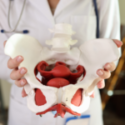Pelvic organ prolapse is a type of pelvic floor disorder where the muscles and tissues that hold the pelvic organs in place weaken and drop lower into the pelvis. “Prolapse” refers to the drooping of pelvic organs that include the cervix, uterus, bladder, vagina, small intestines, and rectum. Symptoms of pelvic organ prolapse can occur when there is increased pressure in the abdomen, most commonly in women who have given birth, but not always. Some women only have minor symptoms, if any at all.

There is more than one type of pelvic organ prolapse, including:
Issues treated may include:
In addition to childbirth, risk factors for developing pelvic organ prolapse include a family history of the condition, obesity, advancing age, hysterectomy or prior pelvic surgery, menopause, intense physical activity, and more. Conditions such as asthma or constipation are a risk factor due to the increased intra-abdominal pressure.
Many women experience no symptoms at all, sometimes even discovering the condition during a routine gynecological exam. Symptoms vary on which organ is drooping, for example, if urine is leaking, the bladder might have prolapsed. Other symptoms include:
For successful treatment, diagnosis of the exact cause is critical. A simple pelvic or rectal examination is completed as part of a complete physical examination for a diagnosis. During the appointment, your doctor will attempt to determine the severity of the prolapse, typically by observation of the vaginal walls and cervix. Your doctor also might even ask you to strain to cough during the exam.
Depending on the severity of uterine prolapse, your age, and other factors treatment options include:
If you have any pelvic health concerns, please call us at 770.720.7733 or schedule an appointment with one of our board-certified doctors.















CANTON
227 Riverstone Drive
Canton, GA 30114
WOODSTOCK
100 Stone Forest Drive, Suite 200
Woodstock, GA 30189